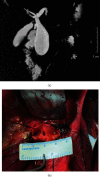Standardized Surgical Management for Cystic Dilation of the Bile Ducts Based on Clinical and Pathological Studies: A Narrative Review
- PMID: 33014038
- PMCID: PMC7512076
- DOI: 10.1155/2020/3432786
Standardized Surgical Management for Cystic Dilation of the Bile Ducts Based on Clinical and Pathological Studies: A Narrative Review
Abstract
The surgical method of complete/radical cyst excision plus Roux-en-Y hepaticojejunostomy remains the primary therapy and the only effective treatment for cystic dilation of the bile ducts (CDBDs). However, the incidence of long-term postoperative complications is still high, as is the reoperation rate, and the potential for postoperative malignant transformation still exists. In recent years, significant progress has been made in understanding the pathogenic mechanism and pathological changes of adult CDBDs. Based on which, the surgical procedures for CDBDs have been revised to further improve their effectiveness. The purpose of this review is to systematically summarize the latest concepts of the etiology and pathogenic mechanism and the pathological changes of adult CDBDs. Based on the findings of these clinical and pathological studies, a comprehensive theoretical system in the surgical treatment of CDBDs has been established, which corrects many previous theoretical misunderstandings. The specific surgical method for each type of CDBDs and the key technical notes are also described in detail. Using these principles, treatment outcomes for CDBDs can be significantly improved, and the current high complication rate, reoperation rate, and rate of postoperative malignant transformation can be reduced.
Copyright © 2020 Hong-Tian Xia.
Conflict of interest statement
The author declares that there is no conflict of interest regarding the publication of this article.
Figures




Similar articles
-
Better long-term outcomes with hilar ductoplasty and a side-to-side Roux-en-Y hepaticojejunostomy.J Surg Res. 2017 Jul;215:21-27. doi: 10.1016/j.jss.2017.03.036. Epub 2017 Apr 1. J Surg Res. 2017. PMID: 28688649
-
Outcomes of choledochal cysts with or without intrahepatic involvement in children after extrahepatic cyst excision and Roux-en-Y hepaticojejunostomy.Ann Hepatol. 2012 Jul-Aug;11(4):536-43. Ann Hepatol. 2012. PMID: 22700636
-
Extrahepatic cyst excision and partial hepatectomy for Todani type IV-A cysts.Dig Liver Dis. 2014 Nov;46(11):1025-30. doi: 10.1016/j.dld.2014.07.007. Epub 2014 Sep 2. Dig Liver Dis. 2014. PMID: 25190435
-
Laparoscopic resection of type I choledochal cyst in an adult and Roux-en-Y hepaticojejunostomy: a case report and literature review.Surg Laparosc Endosc Percutan Tech. 2006 Dec;16(6):439-44. doi: 10.1097/01.sle.0000213768.70923.99. Surg Laparosc Endosc Percutan Tech. 2006. PMID: 17277665 Review.
-
Recent advances in pathophysiology and surgical treatment of congenital dilatation of the bile duct.J Hepatobiliary Pancreat Surg. 2002;9(3):342-51. doi: 10.1007/s005340200038. J Hepatobiliary Pancreat Surg. 2002. PMID: 12353145 Review.
Cited by
-
Surgical Management of Recurrence of Primary Intrahepatic Bile Duct Stones.Can J Gastroenterol Hepatol. 2023 Jan 23;2023:5158580. doi: 10.1155/2023/5158580. eCollection 2023. Can J Gastroenterol Hepatol. 2023. PMID: 36726399 Free PMC article.
References
-
- Todani T., Watanabe Y., Narusue M., Tabuchi K., Okajima K. Congenital bile duct cysts. Classification, operative procedures, and review of thirty-seven cases including cancer arising from choledochal cyst. American Journal of Surgery. 1977;134(2):263–269. doi: 10.1016/0002-9610(77)90359-2. - DOI - PubMed
Publication types
LinkOut - more resources
Full Text Sources
Research Materials

